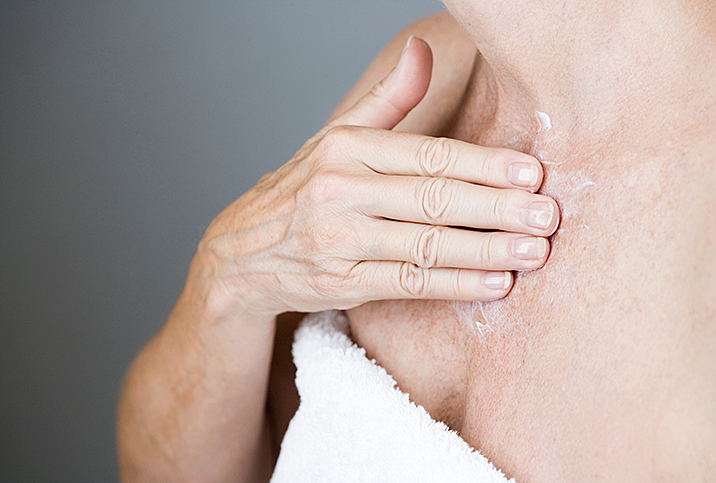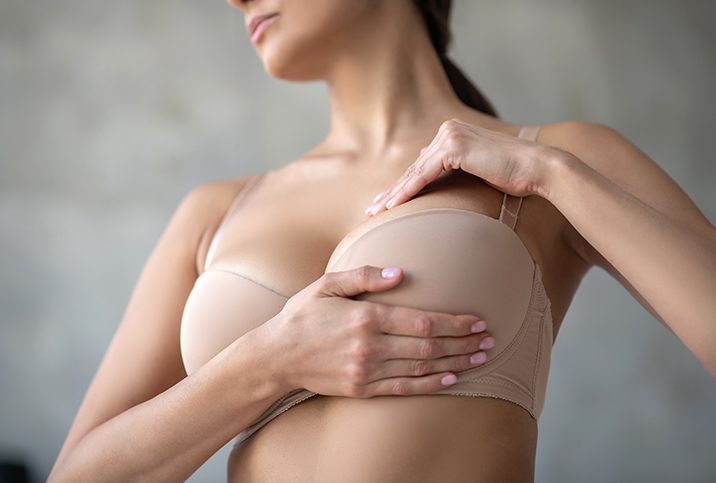Are There Any Nonsurgical Ways to Stop Breast Sagging?

If you Google how to save your sagging breasts, you'll see myriad creams, home remedies and exercises claiming to fix the problem. But it's hard to know if any of these claims can be substantiated.
While surgery is an option, it's not a viable one for many people. We talked to the experts about what causes breasts to sag and what realistic steps you can take to prevent or deal with the problem.
The causes of sagging
The medical term for sagging breasts is "breast ptosis." It's normal, common and likely to affect most women to some extent. But depending on the extent, breast ptosis can cause some people to feel insecure about their body.
"In order to understand the problem, it is important to understand what the breast is made of," said Lisa Schneider, M.D., a board-certified plastic surgeon with Rowe Plastic Surgery in Jersey City, New Jersey. "The breast is made of three parts: skin, fat and breast tissue. The interplay of these three components will affect how the breast sits on the chest and how your breast ages over time."
Several factors contribute to breast sagging, and for many women, some sagging is inevitable, according to Javad Sajan, M.D., a leading Seattle plastic surgeon at Allure Esthetic.
These factors include:
- Age. As we age, the ligaments in the breast tissue stretch and lose elasticity.
- Smoking. This accelerates the aging process, contributing to a loss of elasticity in the skin.
- Menopause. The loss of collagen through menopause can contribute to breast sagging.
- Excess sun exposure. Ultraviolet rays can damage the skin and also cause loss of elasticity.
- Rapid weight gain and loss. Drastic fluctuations in weight can stretch the breast, leaving it saggy.
- High body mass index (BMI). The increased gravitational pull of larger breasts can increase the amount of sagging.
Hang on. You may think breastfeeding was left out. Interestingly, research indicates that breastfeeding doesn't actually have a negative effect on the breast shape. Yes, the risk of breast sagging increases with each pregnancy due to weight gain and loss, but breastfeeding itself does not affect the breast shape.
The amount of elastin in the dermis, the connective tissue layer of the skin, varies from person to person, largely for genetic reasons, according to Constance M. Chen, M.D., a board-certified plastic surgeon and breast reconstruction specialist in New York City.
Prevention is key
Sajan advised that once the breasts have taken on a noticeably saggy appearance, there is no nonsurgical way to fix them.
"It can be helpful to wear a supportive bra. But once the ligaments stretch, it is not usually possible to unstretch them," Chen added.
However, prevention is the key, according to Schneider.
"Not smoking, or quitting smoking if you smoke currently, is one of the most critical prevention factors," she said.
Sajan noted that caring for the skin of your breasts can also help maintain the skin's quality and elasticity, which may help prevent sagging. Make sure to wear sunscreen on all exposed skin—not just to protect you from unwanted breast sagging, but to help prevent skin cancer, too.
What about those breast creams?
"Once the breasts have sagged, no cream will perk them up," Sajan said. "If you are currently breastfeeding or want to treat stretch marks, some creams may help alleviate these and help the skin retract naturally."
However, he added that creams do not guarantee the breasts will remain perky or return to their original appearance. Both Chen and Schneider concurred there is no research to show a breast cream can help.
"I have not seen any evidence that these creams would do anything more than improve the skin quality, which is not the same thing as reducing breast sagging," Schneider stated.
Lifestyle changes
Diet and exercise are great for your overall health, and may influence the appearance of your breasts, one way or another.
"In general, keeping slim, fit and trim may help keep breasts smaller, which can keep the weight off of breasts, thus minimizing sagging and drooping," Chen advised.
However, Schneider pointed out that significant weight loss, which overall is very good for your body, will likely contribute to breast sagging if your breasts contain a lot of fat.
Maintaining a healthy lifestyle, looking after your skin, stopping smoking and mitigating major weight changes are great ways to prevent breast sagging, according to Sajan.
Options for treating breast sagging
"Some people may be able to prevent sagging through a healthy diet and exercise," Sajan said. "However, for some, a combination of genetics, having children and various other factors do make saggy breasts inevitable."
He advised that surgery is the most effective option and the only one guaranteed to restore perkiness to sagging breasts.
"Accepting the shape of your breasts or undergoing surgery to change the shape of your breasts are generally your two primary options," Chen said.
Acceptance is entirely normal. If your breasts are sagging, and it doesn't bother you, then there is no need to worry. You don't have to make any changes to your body. Embrace it and be body positive.
For women who find breast sagging affects their self-esteem, Schneider had some advice for those considering surgery: "Remember, this is a very safe surgery that works to change your body's skin and fat, so patients often recover quickly. Look for doctors who make you feel comfortable; don't be shy about going to see more than one to make sure you have a good fit with your surgeon."
If you're stressing about the sagging of your breasts, perhaps don't rush out and spend a lot of money on a breast-lifting cream and instead focus on lifestyle changes and body acceptance.
"Nonsurgical ways to improve breast appearance will involve a healthy lifestyle, like quitting smoking and maintaining a healthy weight. The only 'quick fix' to change the breast dramatically would be surgery," Schneider said.


















